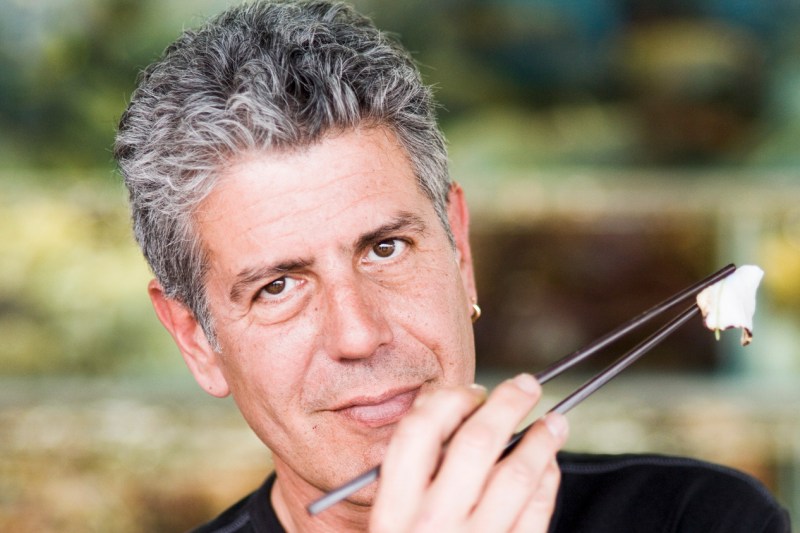Two years. It’s been two years since Anthony Bourdain killed himself. I remember where I was, what I was doing, and who I was with. That was a moment for me – as for many people both in the service industry and not – that I will not forget. Ever. I remember the squid ink arancini, and the fresh fettuccini in a light garlic sauce, and the pizza – oh, that truffle-topped pizza. Those are the things that are forever ingrained in my mind as much as the exact moment when one of the people on my trip, still sitting at the table while I stood (ready to go find a Negroni in Florence, Italy, the home of the Negroni) casually said “Oh, look what happened” and turned his phone around to show me the news headline. If you’ve never had something turn to ash in your mouth, that is a moment that invokes that feeling.

I’ve written on Bourdain’s legacy before, and I still stand by those words. I wouldn’t be who I am without what he’s done. When he killed himself, it opened up wounds for many people. Not only was a celebrity dead, he was dead by suicide when for all intents and purposes he had a dream job. It opened up conversations about mental health that are still ongoing (and hopefully will not stop). Depression is easy to hide when the front stage of a person’s life looks so fucking cool.
At the time of his death, Bourdain was filming the twelfth season of his hit show Parts Unknown. The season, which spans seven episodes, is a fitting last showing of who Bourdain was and what he did best – tell stories. The series finale aired a few months following Bourdain’s death, but I didn’t watch it. I couldn’t. In the immediate aftermath, it was still too heart-wrenching. I could hear his voice in my head if I conjured up his image, but seeing the final episodes and knowing that they would be the very last ones was not something I was mentally or emotionally ready for. I wanted to put it off in the way that you save that last piece of chocolate, or that special vintage of wine – at least that is what part of me told another part of me. I think, though, that the majority of me was scared to watch it. What would it dredge up? What would happen when it finally ended? Yes, television is a medium that we can play and replay – the joys of streaming services, et cetera – but like watching any other favorite show, or listening to a favorite album, the first time is always different. You’re seeing it with new eyes, with a blank slate that is being imprinted on moment by moment. Will you get more out of it later? More than likely, but it’s that first viewing that creates the base for any future experience. What happens when that first experience is part of a final experience?
It took me one year and 363 days to work up the … whatever … to sit down and watch the final season. And when I did, I was reminded immediately and consistently of why Bourdain was so beloved by countless people around the globe.
While you get a “standard” episode to start the season – he visits Kenya with comedian Kamau Bell – the rest of the episodes are slightly different by necessity. In the second episode, it begins to hit home. Episode 2 takes place in Spain, and Bourdain is joined by chef and humanitarian Jose Andres. For most of the episode, it seems like a normal one – Bourdain digging into the culture of a people through food, through politics, through having fun with a friend – but there is a moment where that changes and it hits like someone coming up behind you and snapping a rubber band on your neck. One scene cuts to Andres smoking a cigar, talking about how Bourdain was. Not is, was. It’s the first moment, the first indication that this really all is coming to an end. And because you don’t expect it, it hits hard.
The next episode though, shot in Indonesia, is really where you feel it. The episode starts not with Bourdain’s voiceover, but with narration by another person, Kadek Adidharma, who explains the cycle of death in Indonesia – which on its own is unsettling enough, but when you know what happens, the entire episode becomes much, much heavier. The weight of that story presses down on you, especially in moments in the episode (wherein Bourdain attends a funeral and cremation ceremony) that are simply haunting. At one point, Bourdain is asked to describe the food in front of him.
“No, I’ll get it in VO because I’ve had it before.”
The thought that there would be a VO, that something so simple – describing a dish – would never happen sits with you throughout the rest of the episode and into the remaining four episodes after.
That line, for all we know, would’ve been a throwaway in any other circumstance, something left on the cutting room floor with the tons of other footage that didn’t make it into the completed episode. But this episode like others in the season, was incomplete. There was not time to complete it – death came first.
The series ends in a fitting way, with Bourdain exploring the Lower East Side, the place that shaped him. He may have spent years traveling the world, but in the end, there would always be a homecoming. We should all be so lucky that our story – stories, again, were what he set out to tell – can begin in one place and be able to find its way back.
One of the things that I wondered about, and continue to wonder about, is what would Bourdain say now? What would he be doing now in these turbulent times? He was always the person that stood up for the people that were so often overlooked. He told the stories that needed to be told, the ones that most of us would never even contemplate investigating. He did it with love, and humbleness, and razor-sharp insight into telling the story the right way – by shutting the fuck up and letting the people themselves say what needs to be said.
With that, what would he be saying? What would he be doing? I think we know the answer, but just as we look to others to be guiding voices, I’d put money down that he would’ve been one of them, showing us what we need to do to be better people for people, how to look outside ourselves, and our experiences to help others when they need it.
It’s only been two years since Bourdain died, but it feels like much longer. In looking back at his life and legacy, it provides a light, a path, to hopefully, be more open-minded, more understanding, more willing to fight for what’s right.



